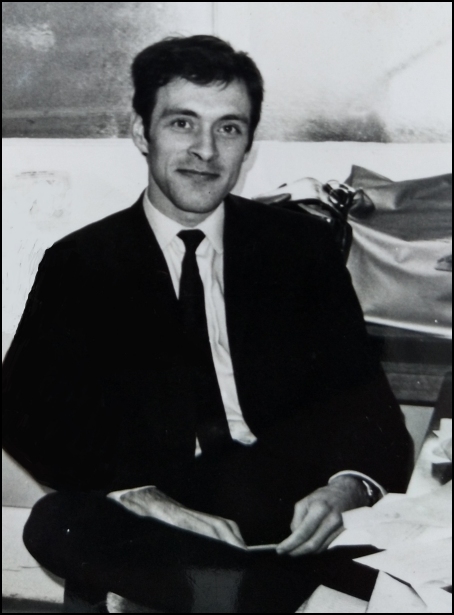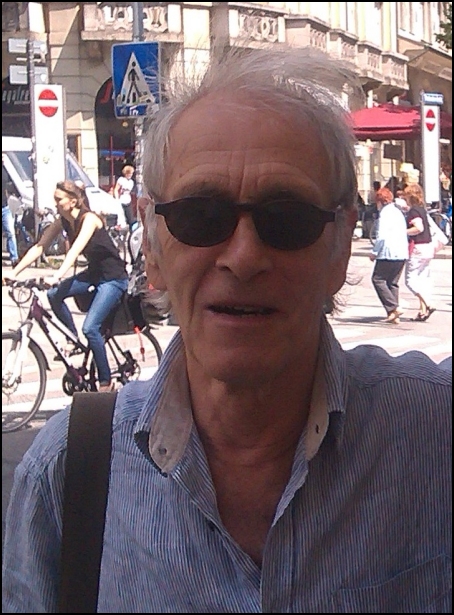

I joined Pan from Panther Books, where, under Barry Rowland and John Boothe who was later to co-found Quartet I wrote blurbs, promotional material and reports on incoming hardcovers to assess their paperback potential. Panther's covers were very different from Pan's in one respect, due to the influence of Joe Pacey, joint owner of Panther. Pacey was very much hands-on as well as being a notorious cost-cutter, as has been recorded by various hard-done-by authors of Panther paperback originals. The company had bought in a stock of transparencies of illustrations that had already been used on other publishers' books, mainly American. Using these instead of paying artists to produce cover illustrations from scratch naturally saved money. The trouble was that Pacey had scant regard for whether any particular ready-made illustration was suitable for any particular Panther title -- not that he would have read it anyway. Officiating at many of the cover selection meetings, he would riffle through the box of transparencies, select one he liked and decree: 'Use that, laddie'. So some demure brunette in the story would appear as a blonde femme fatale on the cover and her dignified lover as a leering debauchee. Pan was free from this nonsense: original artwork was commissioned to ensure that cover was faithful to text well, for the most part, anyway!
Headfort Place was a narrow backwater virtually free of traffic, close to Hyde Park Corner. The cramped offices like those of many publishers then were on the first floor, reached by a flight of wooden stairs just inside the scarcely noticeable entrance. I shared a small office with Stan Boswarva, who co-ordinated copy, artwork, cover design and lettering and was answerable to the editorial director, Clarence Paget. (Bos, as he was always known, was a heavy smoker 60 a day and in that smoking-OK time and in that fume-blue space I, a non-smoker, became a passive one for nearly three years.) The one window, beside me, looked on to a well in whose inner courtyard below were tubbed lollipop bay trees. The light, the shadows, the reflections in that cloistered space acted as a kind of barometer for me of the weather in the world beyond -- in Hyde Park, for instance, where, if the well-barometer read Set Fair, I would at summer lunchtimes play cricket with certain staff members, including Simon Master, stepson of the chairman, Aubrey Forshaw. Simon was at Pan learning the ropes and would later go on to become a big cheese at Random House.
Once the copy was written Bos would get the artists' agent Tony Bowen-Davies in to choose a suitable artist to produce the cover painting. When copy and artwork were ready for several books, Edward Young (who designed the Penguin logo and as a war hero wrote the 1000th Pan, One of Our Submarines) would come in to discuss them and take copies away to design the front and back covers. Finally, a lettering artist (we're talking pre-Letraset days) would hand-letter title and author for the front cover panel. One of the celebrated Raymond Hawkey Bond covers that has stuck in my mind was that for On Her Majesty's Secret Service, which was realised and photographed in the office. Its snow and blood were actually table salt and red ink and the ring was Bos's wedding ring.
Tony Bowen-Davies, who had his office in Beauchamp Place, was from a family with eminent political and literary connections, among them Winston Churchill and Clemence Dane. Tall and slim, he held himself well and was always immaculately turned out in well-cut charcoal suits, white shirt, old-school-or-regimental-type tie and gleaming black shoes. His dark hair was pomaded and brushed flatteningly back to a patent leather that almost matched the sheen of his toecaps, and on the top lip of his fine-boned face sat a black toothbrush moustache. He was given to impetuous, boyish enthusiasms that contrasted oddly with the Guards-officer-in-mufti appearance.
A regular visitor to our office from his own was Paul Chevalier, the PR man. Paul was filled with a restless energy and, like Tony, was habitually, and I must say enviably, excited about something or other. He would burst into our office with breathless news of the latest Pan film tie-in, or any film news for that matter: 'Guess what....? One perk of his job through the tie-ins was free invites to film premieres and special showings and I remember he gave me tickets for my wife and me to attend a private screening of Tom Jones at which there were some of the cast. He wrote thrillers, under the pseudonym Eugene George, his middle two names. The first successful one, I Can See You But You Can't See Me, was paperbacked by Pan.
Unlike at Panther, I did nothing but write blurbs at Pan. For books you enjoyed or admired you set about writing selling copy with some relish; for those that were of indifferent quality you got on with the job with what amounted to a mental shrug; but for the occasional real stinker, so bad that you wondered -- along with Bos and Paul -- why the expletive it had been bought in, you had to grit your teeth to crack it up in the usual way, to persuade people to waste their money on it.
Occasionally a notable author would appear in our room. One was Arthur C. Clarke, which was a thrill for Bos, a sci-fi fan. And, as in offices everywhere, many amusing episodes took place, some of them bizarre ('the realm of the fantastic' was how Gogol described the office); and there were quite a few 'characters' as they are generally called. But discretion and the civility of a newsletter forbids me from going into any of that.
After three years at Pan I left the world of paperbacks to work at the London office of an American hardcover company, the Greystone Press. Six months later Pan asked me to return, at a much higher salary. I turned down the offer. The four years of continuous blurb writing had been interesting, often enjoyable, often challenging, but I knew that I didn't want to continue doing that indefinitely.
All the people I knew at Pan in those days that I have been able to track down are now dead: Stan Boswarva, Tony Bowen-Davies, Paul Chevalier, Simon Bott, Edward Young, Simon Master, Aubrey Forshaw, Clarence Paget, sales director Ralph Vernon-Hunt, who posed for a cover Bond, export manager Robin Neilland -- and no doubt others.
In one aspect the people, places and events of those days are now remote -- that is, when placed there by my acceptance of chronological time. But as we all know our perception of time is binary, and personal time for me draws them anachronistically near. So that whereas some places I worked at much later during the rest of my career in publishing are now scarcely discernible in memory and to all intents and purposes are remote, it is, conversely, with the clarity of the recently experienced that I now see and hear in that room I worked in Tony enthusing about one of his artists, Paul eagerly sharing his film tie-in news and Bos discussing with me his favourites among that month's books